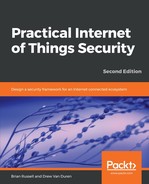Your threat model should identify whether there are threats to your IoT systems associated with jamming attacks. This threat is different for each type of IoT system.
For example, unmanned aerial systems might be highly susceptible to jamming attacks. In this case, mitigations such as building in logic within the drone to Return to Launch (RTL) is important (although this assumes the availability of Global Positioning System (GPS) satellite connectivity). Without these safeguards, the drone might simply be lost, or, worse, crash into someone on the ground.
Connected vehicles represent another critical IoT system for which jamming is a major concern. The suppression of Basic Safety Messages (BSMs) from one vehicle to another, or messaging from Roadside Units (RSUs) to vehicles, could result in catastrophic consequences, as vehicles and drivers are not provided with the information needed to make appropriate decisions. The jamming of connected vehicles and drones is of grave concern, partly because of the long range of the RF protocols used within these systems.
There are a number of measures to incorporate into your products and systems to defend against these types of attacks. For example, implementing frequency hopping measures makes it difficult to jam the specific frequency being used to transmit data constantly.
Frequency hopping can be based on simple configurations set between a transmitter and receiver, which is the method seen mostly in today's commercial IoT systems. These configurations dictate the hopping pattern that both nodes will follow. The bandwidth of the frequency band will to some extent determine the usefulness of a frequency-hopping scheme. Larger frequency bands provide greater protection.
There are methods to introduce cryptographic controls into your frequency-hopping scheme. For example, a transmitter and receiver can generate a pseudo-random sequence based on cryptographic keys shared between the two nodes. In this case, the security strength isn't diminished based on the knowledge of a static frequency-hopping pattern contained in a configuration file.
If you have the ability to define the frequency-hopping parameters of your system, it is best to move to an approach such as this.
Also, consider providing your users with some degree of flexibility—for example, support programmable parameters that allow the update of the frequency-hopping algorithm, the frequency, frequency range and step, hop rate, and initialization vector. Providing this flexibility within your product/system design allows users to tailor their approaches based on unique threats that may not be foreseeable today.
